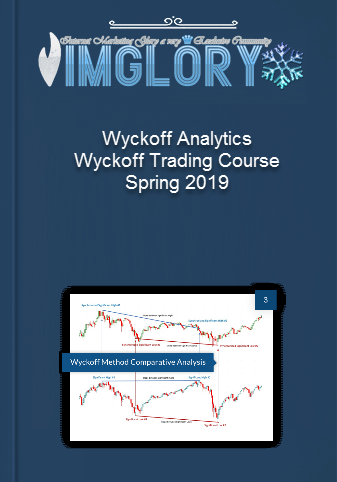
Trading Courses
Wyckoff Trading Course – Wyckoff Analytics – Spring 2019
- Product Name : Wyckoff Trading Course – Spring 2019
- Author : Wyckoff Analytics
- Language : English
- Type : Trading Course
- Price :
$997 - Size : 3.78 GB
- Homepage : Salespage
Develop a foundational understanding of Wyckoff Method analysis, acquiring the knowledge and skills to produce immediate impacts on your trading strategies
Features
-
- Price Structural Analysis
- The Price Cycle Recognition of institutional presence and activity throughout the entire Price Cycle: Accumulation, Mark-Up, Distribution and Mark-Down
- Behavioral Market Analysis Understanding the motivation and behaviors of different groups of market participants, including the Composite Operator, at different junctions within the Price Cycle
- Change of Character Identification of changes in behavior and the overall change of character from a trending to a non-trending environment and vice versa
- Wyckoff Phase Analysis Recognition of Wyckoff Phases within a trading range as timing tools
- Wyckoff Events Structural signals in a trading range — including climaxes, tests, springs, upthrusts, and signs of strength — that signal and confirm the emergence of Wyckoff Phases
- Re-accumulation vs. Distribution Distinguishing typical characteristics of these trading ranges in order to properly analyze Wyckoff Phases and Events
- Supply and Demand Analysis
- Supply and Demand Understanding the two forces that move all markets — this is the cardinal principle underlying the Wyckoff Method and several other approaches to technical analysis
- Effort (volume change) versus Result (price action) Confirmation (harmony) and failure (divergence) as technical analysis tools to predict future price behavior
- Volume and Spread Analysis (VSA) Bar-by-bar analysis of price and volume action to predict the most probable near-term move in market direction
- Volume and Swing Analysis Swing-by-swing analysis of price and volume action to help anticipate when and where the next large opportunity is likely to occur
- Volume Phase Analysis Identification of volume signatures characteristic of specific phases of accumulation and distribution trading ranges
- Relative and Comparative Strength Analysis
- Comparative Analysis Foundations of comparing multiple instruments to each other in order to gauge potential future outperformance
- Relative Analysis A modern tool for comparative analysis of different financial instruments and how to choose the best ones to trade
- Advantages of Relative Strength Understanding the benefits of applying relative strength analysis to select the best trade candidates, particularly at market turns
- Top-Down Analysis Introduction to top-down analysis of sectors, industry groups, and stocks
Download Via UploadGig
https://uploadgig.com/file/download/3fd0F6a90587929A/WYCKOFF.TRADING.COURSE.WTC.SPRING.2019.DL-IMGLORY.z01
https://uploadgig.com/file/download/c9Ca0ce0859e1bEe/WYCKOFF.TRADING.COURSE.WTC.SPRING.2019.DL-IMGLORY.zipDownload Via Nitroflare
http://nitroflare.com/view/3D1E96980BD7DE6/WYCKOFF.TRADING.COURSE.%28WTC%29.SPRING.2019.DL-IMGLORY.z01
http://nitroflare.com/view/8743DCB608EC11A/WYCKOFF.TRADING.COURSE.%28WTC%29.SPRING.2019.DL-IMGLORY.zipPassword : www.imglory.net


![Free Share 13 MARKET MOVES FORMULA [Free Share] 13 MARKET MOVES FORMULA](https://www.fastrls.net/wp-content/uploads/2022/04/Free-Share-13-MARKET-MOVES-FORMULA.png)
![Free Share Scott Pulcini – NQ Full Order Flow Course [Free Share] Scott Pulcini – NQ Full Order Flow Course](https://www.fastrls.net/wp-content/uploads/2022/04/Free-Share-Scott-Pulcini-–-NQ-Full-Order-Flow-Course.png)
![Free Share Greg Capra – Master Trader Advanced Technical Strategies [Free Share] Greg Capra – Master Trader Advanced Technical Strategies](https://www.fastrls.net/wp-content/uploads/2022/04/Free-Share-Greg-Capra-–-Master-Trader-Advanced-Technical-Strategies.png)
![Free Share Apteros Trading – Fall 21 Intensive [Free Share] Apteros Trading – Fall ’21 Intensive](https://www.fastrls.net/wp-content/uploads/2022/03/Free-Share-Apteros-Trading-–-Fall-21-Intensive.png)